In our tiny little town, we have tiny little backyards. Our home sits on less than 1/5 of an acre, actually.
Yet, we strive to grow 75-80% of our own food each year. It’s truly possible, you just need to know how to maximize your growing space. Here are a few tips to help you maximize your gardening space.
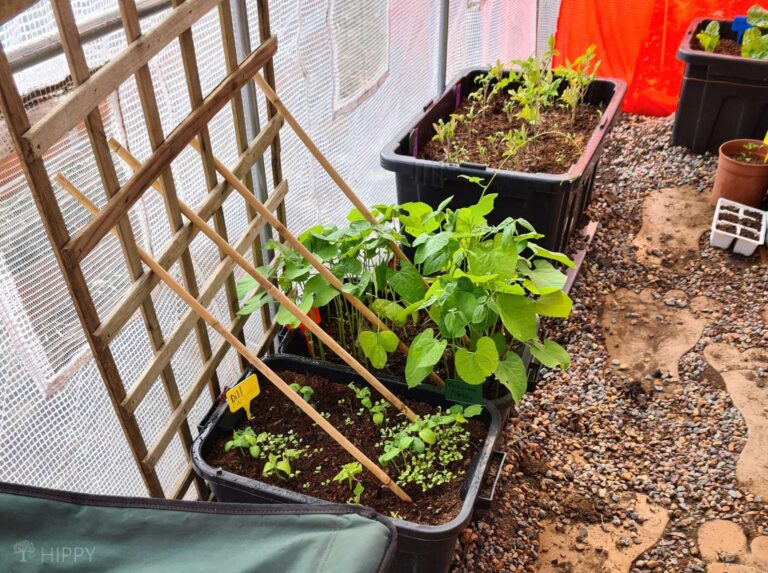
Use Succession Planting
I can’t say this enough. You should try and extend your garden planting by keeping the plants going all season long.
For example, even though peas go from seed to harvest in 60 days, we start ours indoors about 4 weeks before we would normally plant them in the ground.
We start new seeds every three weeks indoors as well. This gives us a jump start on them and every three weeks, we are pulling old plants and planting new seeds.
We are able to get over 300 plants in a season in one 16’x2′ bed this way. That’s the ONLY way we will ever get enough to be able to preserve some for later.
You can use a hoop house to help you get more growing time, no matter where you live as well.
Think Food, Not Lawn
We gave up the dream of “the perfect lawn” and instead chose to grow food. Our backyard is 90% food… either for us, the bees, or the chickens.
We have just a tiny spot with lawn chairs to relax and enjoy the beauty that is our garden, and watch our chickens peck at the ground.
Grow Stealthily
You can make it pretty by planting lots of flowering vegetables, especially on the outer edges. I like to put purple beans, edible flowers, and peas on the edges.
That just makes it look so colorful. Think of vegetables with gorgeous flowers like cucumbers, tomatoes, and eggplants.
Think outside the Bed and Box
If you have a fence, try hanging gutter or old soda bottles or even use buckets to grow plants in. Those pretty flower boxes that can hang on a deck? They are great for lettuce, carrots, or even radishes.
Tom Thumb peas also grow great in these boxes, and you can get 2 bushing pea plants that can produce a lot of peas in one flower box. Chives, spinach or even strawberries grow great in boxes that can be lined up on a balcony or patio.
Use Lots of Containers
If you don’t have a large lawn, or if you live in an apartment, you can grow lots of veggies in containers.
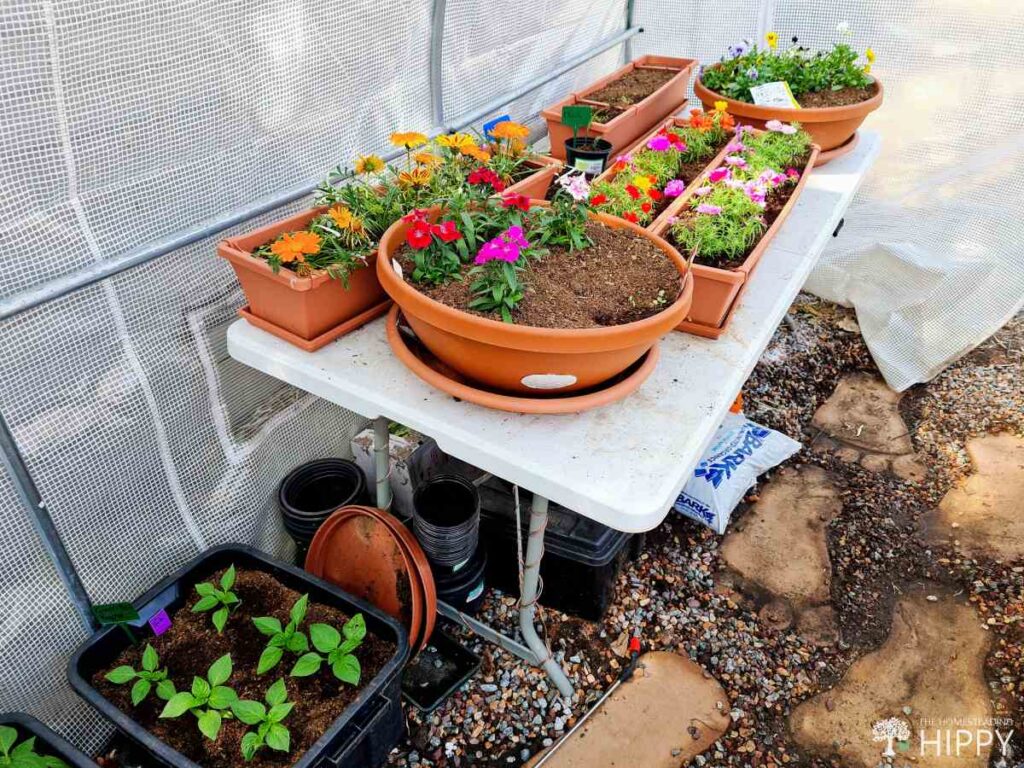
A 5 gallon bucket will hold a tomato or cucumber plant easily, and takes up less than 1 foot of space. You can also move them around, if need be to get more sun. Potatoes, green beans, swiss chard and even zucchini are also great in buckets.
Go Vertical with Your Garden
Instead of planting sprawling plants like zucchini, squash, or pumpkins flat, train them onto a trellis. You’ll get the same harvest with much less space usage.
Another benefit of growing vertically is that you can get creative and create shade for chickens, ducks or rabbits where there was no natural shade before.
Think outside the Yard
Grow your herbs in your kitchen windowsill, or even lettuces. You can use an old colander hung on an old plant hanger to grow a salad garden that takes up very little space.
Use Every Space in Your Yard
If you grow it for the root, or the fruit, you need full sun.(think potatoes, tomatoes, peppers) BUT, if you grow it for plants or leaves, you can put it in a more shady area. (think lettuces, peas, broccoli and cauliflower).
Focus on Great Soil Quality
While there are many factors to consider when designing a garden, one of the most important is the quality of the soil.
Healthy soil is essential for strong plant growth, and it can also help to prevent problems such as eutrophication and compaction.
As such, it is important to take steps to ensure that your soil is of the highest quality possible. One way to do this is to focus on maximizing the amount of organic matter in the soil.
This can be done by using compost or manure, as well as by adding other organic materials such as leaves or grass clippings. In addition, it is important to make sure that the soil is well aerated and has adequate drainage.
Fertilize Often
In order to have a healthy and bountiful garden, you need to fertilize it on a regular basis. By doing this, you will ensure that your plants are getting the nutrients they need to grow strong and thrive.
Fertilizing also helps to promote root growth, which will help to anchor your plants in the soil and prevent them from being blown away by strong winds.
In addition, by keeping your garden well-fertilized, you will be able to maximize the amount of space that you have available for planting.
This is because plants that are properly nourished are likely to grow larger and healthier than those that are not receiving adequate nutrition.
Try Intensive Planting Methods Like Square Foot Gardening
If you’re looking to get the most out of your garden space, you may want to try intensive planting methods like square foot gardening. With this approach, plants are spaced closer together and planted in grid-like patterns.
This allows you to fit more plants into a smaller area, and it can also help to improve air circulation and promote root growth.
In addition, intensive planting can help to deter pests and diseases, as the close spacing makes it difficult for them to spread. If you’re interested in trying square foot gardening, there are a few things to keep in mind.
First, make sure to choose plants that have similar water and nutrient needs. Second, pay attention to the mature size of your plants, as you’ll need to thin them out as they grow.
Rotate Your Crops
As any experienced gardener knows, crop rotation is an essential part of maximizing the yield of your garden.
By rotating your crops, you ensure that your plants get the nutrients they need from the soil, and you also help to prevent the spread of disease.
In addition, crop rotation can help you to make the most efficient use of your garden space. By growing different crops in different areas of your garden, you can ensure that each plant has the room it needs to thrive.
As a result, crop rotation is a simple but effective way to improve the yield of your garden.
Give Companion Planting a Try
Companion planting is a gardening technique that involves growing two or more plants close together in order to maximize space and resources.
This practice can be used to improve the yield of a garden, deter pests, and attract beneficial insects.
For example, planting tall crops like corn next to shorter plants like beans can help the beans to climb up the corn stalks, saving space in the garden bed. The three sisters planting method is a classic way to do this.
Similarly, interplanting pest-repellent herbs like basil and mint can help to keep harmful insects away from other plants. Companion planting is a simple way to make your garden more efficient and productive.
Use Hydroponics Indoors
Hydroponics is a type of gardening that doesn’t require soil. Instead, the plants are grown in a nutrient-rich solution or in an inert medium, such as gravel or sand.
Because hydroponics doesn’t rely on soil, it’s possible to grow plants indoors in a controlled environment. This can be especially useful if you have limited space for gardening.
By growing plants hydroponically, you can maximize your garden space and get the most out of your indoor garden.
Plant Fast-Maturing or High-Yield Vegetables
As any gardener knows, choosing the right plants for your garden is essential for a successful harvest. While many vegetables take several months to mature, there are a few varieties that can be harvested much sooner.
Fast-maturing vegetables like radishes and leafy greens can be ready to harvest in just a few weeks, while others like tomatoes and peppers usually take a bit longer.
High-yielding vegetables are also a good choice for maximizing your garden space. Varieties like beans, peas, and squash produce an abundance of fruit or pods, so you can get more bang for your buck.
When planning your garden, consider planting a mix of fast-maturing and high-yield vegetables to make the most of your space and time.
Opt for Dwarf Varieties
One way to get the most out of your garden is to choose dwarf varieties of plants.
Dwarf plants are genetically programmed to stop growing at a certain height, which means they don’t require as much room to spread out.
As a result, you can pack more plants into a smaller space, and you can enjoy all the benefits of a lush garden without having to take over the entire backyard.
Grow in Mounds or Spirals
In a small garden, every square inch of space counts. That’s why it’s important to choose your planting patterns carefully. One way to make the most of your space is to grow in mounds or spirals.
This type of planting allows you to pack a lot of plants into a small area without sacrificing air circulation or sunlight exposure. When done right, mounds and spirals can create an eye-catching design that is both functional and beautiful.
Use Edible Landscaping
When it comes to gardening, many people think of traditional methods like planting vegetables in rows or having a separate area for flowers.
However, there is another option that can provide you with both beautiful scenery and delicious produce – edible landscaping. Instead of planting decorative shrubs or ornamental flowers, edible landscaping focuses on incorporating edible plants into your yard.
This can be done in a number of ways, such as growing fruit trees as boundaries or adding berry bushes along walkways.
Not only does this provide you with fresh fruits and vegetables, but it can also save you money on groceries. In addition, edible landscaping is a great way to maximize your garden space and get the most out of your yard.
Invite Pollinators to Dinner
When most people think about pollinators, they probably envision honeybees. While honeybees are indeed important pollinators, they are not the only ones. In fact, there are a variety of other insects that can play an important role in helping your plants to thrive.
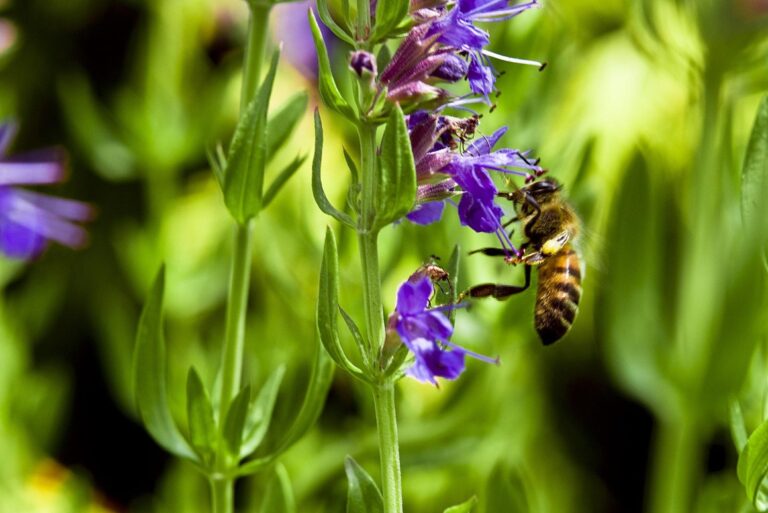
One way to invite pollinators to dinner is to plant a variety of flowers that bloom at different times. This will provide a steady source of food for pollinators throughout the growing season. Another way to attract pollinators is to avoid using pesticides.
Many insecticides are harmful to bees and other pollinators, and they can disrupt the delicate balance of the ecosystem.
Think Multipurpose
When it comes to gardening, one of the best ways to maximize your space is to think multipurpose. For example, consider planting a climbing plant such as ivy or roses near a trellis or fence.
Not only will this add visual interest to your garden, but the plant will also provide natural shade and privacy. Alternatively, you could plant herbs or vegetables that can be used in cooking.
Of course, you can always grow plants that look attractive and can also be eaten, too. Sweet potatoes look beautiful growing up an arbor, and salad greens fill out a deck planter quite nicely.
Not only will this save you money at the grocery store, but it will also give you the opportunity to try new recipes using fresh ingredients.
Grow What You Need and What You Will Actually Use
As anyone who has ever tried to grow their own food knows, space is often limited. For this reason, it is important to choose crops that will give you the most bang for your buck in terms of both yield and nutrition.
While it may be tempting to grow a wide variety of fruits and vegetables, it is often more practical to focus on a few key items that you know you will actually use.
For example, if you are tight on space, consider growing leafy greens or root vegetables instead of fruit trees or sprawling vines.
Not only will this help you to maximize your garden space, but it will also ensure that you are getting the most out of your efforts.
Ditch Rows When Possible
When gardening, one of the best ways to maximize your space is to ditch the rows.
Traditional row gardens can take up a lot of space, and they can be difficult to maneuver around when you’re trying to weed or harvest your crop.
Instead, consider using a raised bed garden or planting in a spiral pattern. You can then ignore row spacing guidelines for a small garden space almost entirely.
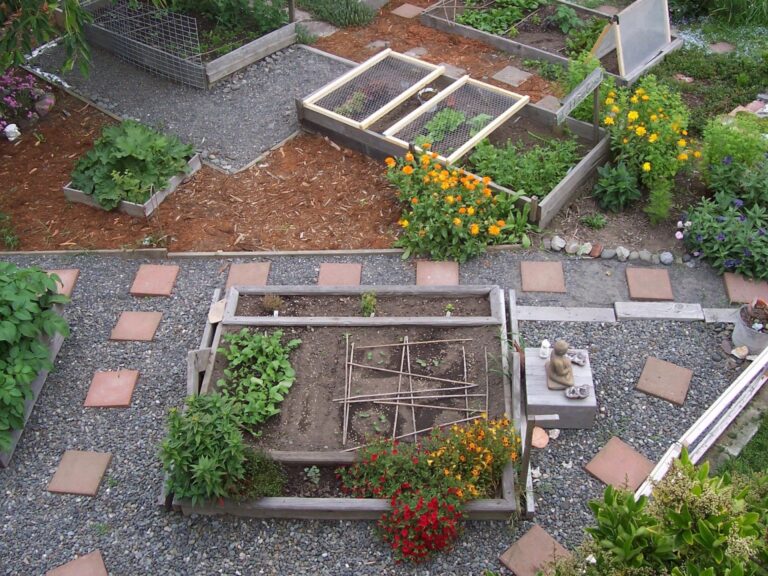
This will not only save you space, but it will also make it easier to reach all of your plants. In addition, you’ll be able to plant more densely, which can actually improve yields.
Grow Nontraditional and Perennial Food Crops
Rhubarb and mushrooms are two nontraditional food crops that can be a great addition to your garden.
Rhubarb is a perennial, meaning it will come back year after year without needing to be replanted. It’s also a relatively low-maintenance crop, requiring only occasional watering and fertilizing.
Mushroom cultivation is a bit more labor-intensive, but it can be well worth the effort. Not only do mushrooms add an interesting flavor to dishes, but they’re also a good source of vitamins and minerals.
Don’t Cage Tomatoes – Tie Them Up
Tomatoes are a popular garden plant, but they can take up a lot of space. If you’re short on space, or if you simply want to maximize your garden’s yield, consider tying your tomatoes up.
By training tomatoes to grow vertically, you can save space and increase the number of fruits that each plant produces.
Tomatoes will need some support to grow vertically, so be sure to tie them securely to a trellis or tomato cage. You should also water them regularly and fertilize them as needed.
Incorporate Small Walkways
When planning your garden, one of the things you’ll need to consider is the size of your walkways.
Many people assume that they need to have wide walkways in order to move around freely, but this isn’t necessarily the case. In fact, by making your walkways smaller, you can actually maximize the amount of space available for planting.
Not only will this give you more room to work with, but it can also help to create a cozier feel in your garden. If you’re not sure how to go about downsizing your walkways, there are a few things you can keep in mind.
First, think about how much traffic flow you realistically need. If you have a small garden, you probably won’t need as much space to move around as someone with a larger one. Second, consider the type of plants you want to include in your garden.
If you’re planning on growing taller plants, for example, you’ll need wider walkways so that you can comfortably get in and out of them.
Always Mulch
Many gardeners find that they can maximize their gardening space by mulching. Mulching is the practice of covering the ground around plants with a layer of material, such as leaves, straw, or plastic.
There are several benefits to mulching. First, it helps to suppress weed growth. Second, it helps to retain moisture in the soil, which can be particularly beneficial during hot, dry summers. Third, it can help to protect plants from extremes of temperature, both cold and hot.
Finally, mulching can help to give your garden a neater appearance. If you are interested in mulching your garden, there are many different materials you can use. Be sure to choose a material that is appropriate for your particular climate and gardening conditions.
Plant in Succession
One way to make the most of your garden space is to plant in succession. This means planning your plantings so that you can harvest one crop and then replant the same area with another crop.
For example, you might plant radishes in early spring, followed by beans in late spring. This type of planting can help you get the most out of your garden space by ensuring that you always have something in season to harvest.
In addition, planting in succession can also help to improve soil fertility, as each crop helps to replenish nutrients that may have been depleted by the previous crop.
Grow in the Shade
Most people think of gardens as sunny places, full of flowers that need lots of light to grow. However, there are actually a wide variety of plants that do well in shady areas.
By growing in the shade, you can maximize your garden space and create a unique and beautiful planting.
One good option for a shady garden is Hostas. These hardy plants come in a variety of colors and shapes, and they thrive in shady areas.
Another great choice for a shady garden is ferns. These delicate plants add texture and interest, and they are very easy to care for.
Grow Plants That Do Double Duty for Landscaping and Culinary Purposes
Growing plants that have multiple uses is a great way to maximize your garden space. For example, herbs can be used for both landscaping and culinary purposes.
Rosemary makes an attractive ornamental plant, with its evergreen needles and fragrant flowers, but it also adds flavor to roasted meats and vegetables.
Similarly, oregano can be used to add color and texture to flower beds, and its leaves can be chopped and added to pasta sauce or pizza. By growing plants that serve multiple purposes, you can create a beautiful and productive garden in even the smallest space.
Try Interplanting
One way to get the most out of your garden space is to try interplanting. This involves planting different types of plants close together in a way that maximizes their space usage.
For example, you could plant tall plants in the back of a bed, medium-sized plants in the middle, and short plants in the front.
This way, each plant gets the sunlight it needs without crowding out the other plants. Interplanting can also help to deter pests, as some pests are only attracted to certain types of plants.
By planting a variety of plants, you can make it more difficult for pests to find the plants they’re looking for.
Extend the Season with Small Hoop Tunnels or Cold Frames
One way to extend the season is to use small hoop tunnels or cold frames. Hoop tunnels are small, portable greenhouses that can be placed over individual plants or rows of plants. Cold frames are similar to hoop tunnels, but they are generally larger and fixed in place.
Both hoop tunnels and cold frames help to protect plants from extreme weather conditions and extend the growing season by a few weeks. In addition, they can also be used to start plants early in the spring or protect them during the winter.
Plants like cabbage, kale, beets, and pole beans all can be grown in cooler temperatures and will thrive in frigid weather, even in a small space.
Season extension is a simple and effective way to get the most out of your garden space. By using hoop tunnels or cold frames, you can enjoy fresh produce all season long even if you have limited space.
Start Small – and Build Up Gradually
When it comes to gardening, bigger is not always better. In fact, starting small and building up gradually can actually be a more efficient use of space.
By planting in stages, you can make sure that each plant has enough room to grow without overcrowding the others.
Additionally, you can make the most of vertical space by training vines (like those from pole beans) to climb an arbor or trellis or planting tall crops like sunflowers along the edge of the vegetable garden.
Finally, using mulch and other groundcover can help to prevent weed growth and preserve moisture. By taking a strategic approach to your garden layout, you can maximize your space and produce a bountiful harvest.
What are some ways you can think of to maximize your garden space? Be sure to pin this to your favorite board for later.
last update 07/27/2022
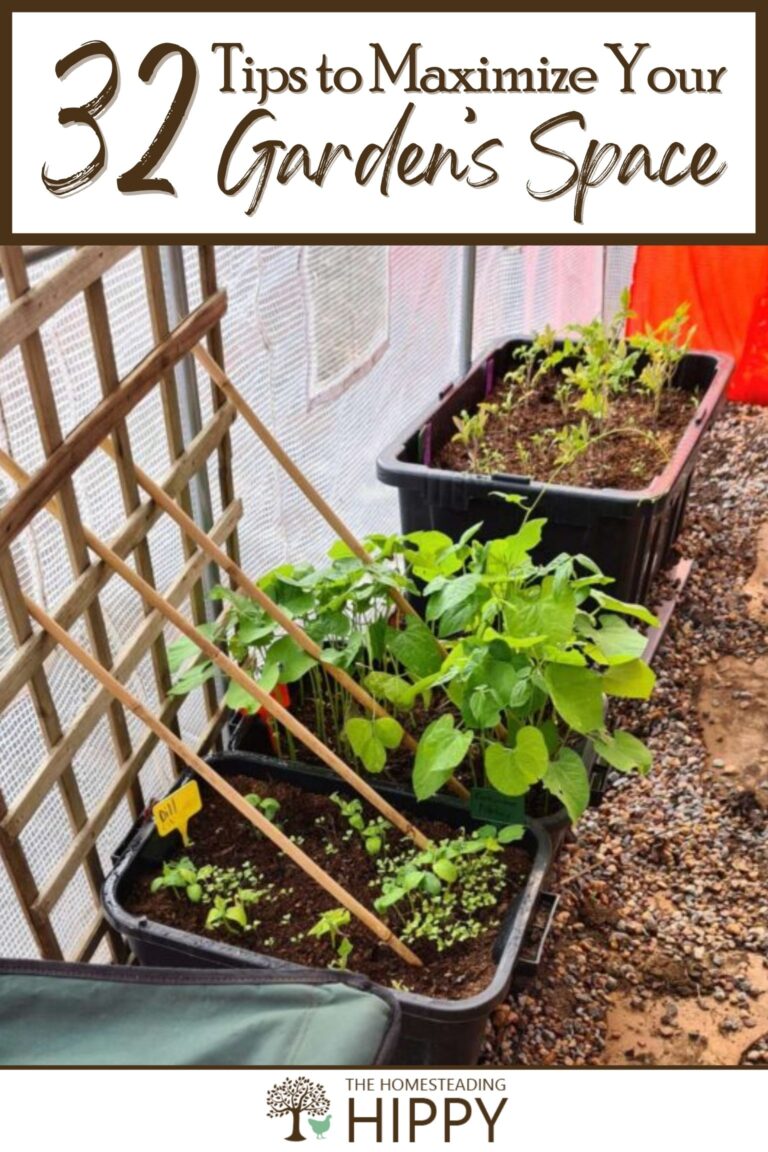
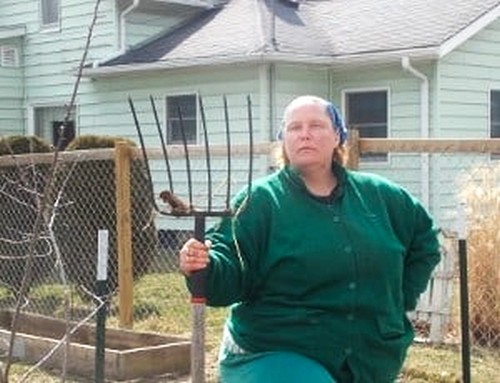
Heather’s homesteading journey started in 2006, with baby steps: first, she got a few raised beds, some chickens, and rabbits. Over the years, she amassed a wealth of homesteading knowledge, knowledge that you can find in the articles of this blog.
Learn more about Heather and the rest of the writers on this page.

Thank you for these great tips. I will try growing lettuce inside so we can enjoy the fresh nutrients all year long as it’s cold and snowy here in the winter. ?
Can’t wait to hear how your garden turns out this year! Be sure to keep us updated on your progress!!
“Think food and not lawn” that quote right there did it for me. Have been planning my garden for this spring and I think am going to incorporate a larger percentage of food planting. Thanks for these great tips.